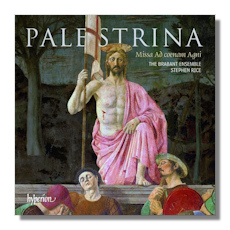
The Internet's Premier Classical Music Source
Related Links
- Palestrina Reviews
- Latest Reviews
- More Reviews
-
By Composer
-
Collections
DVD & Blu-ray
Books
Concert Reviews
Articles/Interviews
Software
Audio
Search Amazon
Recommended Links
Site News
 CD Review
CD Review
Pierluigi da Palestrina

Missa Ad coenam Agni
- Missa Ad coenam Agni
- Surrexit pastor bonus
- Regina caeli
- Haec dies
- Alleluia Tulerunt Dominum
- Terra tremuit
- Angelus Domini
- Deus, Deus meus
- Lauda anima mea
- Benedicite gentes
- Ad coenam Agni providi
The Brabant Ensemble/Stephen Rice
Hyperion CDA67978
The combination of Stephen Rice and his Brabant Ensemble on Hyperion singing a sumptuous collection of works by Palestrina, the most substantial of which (the Missa "Ad coenam Agni") is not otherwise available on CD, should be an enticing combination. It should suggest and promise thoughtful, insightful, precisely-conceived yet uplifting and persuasive music-making. The listener ought to expect technically brilliant yet spontaneous singing of Renaissance polyphony which inspires, provokes and satisfies.
Aspects of the performances to be expected are contrast between Palestrina's many temperaments throughout the Mass itself, which occupies 35 of the CD's 70+ minute length. And a sense of forward movement (listen to the hasty, but not unduly fast, pace of the Credo [tr.3], for instance) to support the liturgical burden of the text… anticipation of a place at the "Lamb's banquet", the "coena agni". Though given its tone, there has to be a risk of too literal (and thus potentially mundane) acceptance of the metaphor. This has to be avoided by angelic yet realistic singing. The text of the Hymn is vivid and down to earth. Yet the melodies and harmonies are heavenly. Lastly, a performance that is not too… "lordly"; but briskly personal and immediate, would surely make for a more satisfying and approachable experience.
In all these Rice and the Brabant Ensemble fulfill every expectation, satisfy every hope and meet every need of the listener to this glorious music. Their very practical and soberly-crafted interpretation also has the virtue of extending inspiration to us listeners because of an implicit respect for the music and text in the singers' wonderfully-clear articulation, phrasing and representation of all sections of the Mass. Listen, for example, to the way in which the sections of the Agnus Dei [tr.5] taper, fall, suggest, and so subtly indicate the sanctity which Palestrina seemed to have felt needed to be emphasized in the context of this Eastertide work. It was an early work, published in 1554 in the composer's first edition of mass settings.
After the Mass [tr.s 1-5] follows a selection of nine antiphons, motets and offertories before the second longest work, at the end of the CD, the sublime seventh century plainsong Hymn on which the Mass is based, Ad coenam Agni providi [tr.15]. These have a freshness, variety and impact which contrasts with, yet enhances, one's enjoyment of the Mass. Indeed they offset one another nicely. While "monolithic" isn't the word for the "Ad coenam Agni" Mass, "consistent" – perhaps even "insistent" – is. These are qualities which the performers convey very well from first to last. Just as they bring a lightness of touch to the shorter works– Regina caeli I [tr.7] almost dances. But these are balanced accounts: to invoke "solemnity", again, would be to overstate Rice's and the Brabants' understanding of the idiom. To describe it as respectfully jubilant and appropriately celebratory would not.
Given the emphasis on Easter in these works, this is a proper juxtaposition of theirs: the Resurrection obviously had two sides for Christians of Palestrina's time. Rice's insight into the best distribution of sorrow with relief, even, and certainly optimism is fully realized by the ten-voice Ensemble, now 15 years old. Their style manages to advocate the glories of (this) Renaissance polyphony without explicitly having to invite our attention. The music is projected and presented with such style, delight and good humor, not to mention unassuming accomplishment, that its merit is self-evident. The active buoyancy with which the Terra tremuit [tr.10] is unfolded testifies to the performers' very firm grasp – a sensible and sustainable determination not to be swept away by imagery ("The earth shook…"). But to inhabit what may well have been the same spirit in which Palestrina must have approached the text for his contemporaries' sensibilities, which were surely less sanguine about extremes (and about confessional pluralism) than are we. Both Deus, Deus meus [tr.12] and Lauda anima mea [tr.13] are uncompromising in this respect. Singers in the 21st century have to convey both the original fervor (because it was essential in the 16th); yet not adopt it disingenuously. This equilibrium is exactly what Rice and the Brabant Ensemble have achieved so successfully on this excellent CD.
The acoustic (of the Oxford church of St. Michael and All Angels, Summertown) is spacious and characterful. It is sympathetic to the many moments of contrast in dynamic in these works – as the (first half) of the Mass's Gloria proceeds, [tr.2], for example. The resonance draws one in in ways on which surely Palestrina would have relied as his music was first sung in the larger spaces of the Roman churches for which it was intended. The booklet is to Hyperion's usual high standards, with brief background to the music and useful information about the performers; and the text in the (Latin) original and (English) translation. Lovers of this repertoire must not overlook this splendid set of performances. The energy and acuity of the Brabant Ensemble and Rice's vision almost guarantee success before they start. On listening to the wonderful final cadences of the Hymn on which the Mass is based at the end of this CD, your faith in that guarantee will be heard to have been well placed.
Copyright © 2013, Mark Sealey





















